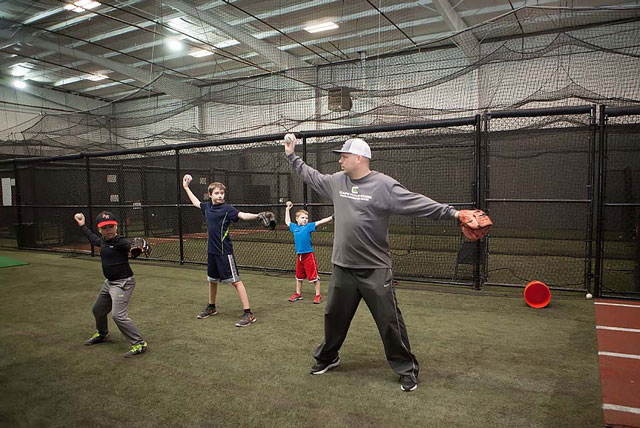At Competitive Edge in Woodbridge, Virginia, the team of expert trainers knows how important it is to condition the complete athlete, not just the physical side. This means training the psychological side, as well as training conditioning to truly strengthen athletic performance.
The physical side of training
When most people think of sports training, this is the part they think about. Austin Brown is the Strength and Conditioning Coach for Competitive Edge. He is a former athlete in the NFL and the Arena Football League. “When you have trainers who have been certified, it helps out a lot more. That’s what we provide at Competitive Edge,” Brown says.
He also says having a good trainer to student ratio helps ensure that students are getting the individual attention they need while still working in a collaborative environment. Students are trained in groups of about six to eight children. They’re grouped by grade level, with grades five through seven in one session and grades eight through 12 in another. This way kids are learning the proper techniques and are able to implement them throughout building their skills.
At Competitive Edge the physical part of training is broken down on a weekly basis. Modules of training include speed, power and strength, which are combined with agility in an hour-long session. The students do warmups for speed and agility, during which they enter a high neural phase. This warmup wakes up the neural system through exercises like speed ladder or quick agility over hurdles.
The psychological side of training
The lesser-known, but equally important, aspect of training is psychological training. This training brings the right mentality to children, teaching them work ethic and how to push themselves.
Brown says athletes who train at Competitive Edge can expect to learn through visual and verbal cues. The goal is for kids training to hear and see the cues and repeat the actions they’ve learned. Trainers emphasize doing things correctly, being safe and working hard.
In order to ensure proper form, trainers demonstrate all exercises before students perform them. New students are added each day at Competitive Edge, so they have a refresher course of cues every day. More experienced students tend to step up as leaders and help guide the new students. “It’s really interesting to watch,” Brown says.
Competitive Edge likes to bring a sense of competition to their training sessions. “Our kids push themselves to a new level during our sessions,” Brown says. But they also talk about being good people, not just being good athletes.
Brown meets with parents, creates a profile for each athlete and does baseline tests. Then they measure against those baseline tests every few weeks to rate progress. “It’s a joy to watch as a former athlete…seeing their confidence being built…it’s nice to see,” says Brown.
“We encourage development of the athlete in more realms than playing different sports. We encourage kids to gain an edge on the competition. If you come in and do two months of work with us, we guarantee you will be a better athlete.”
Why one-sided coaching doesn’t help student athletes

Chad Westgate, Head Coordinator of Competitive Edge manages coaches on the baseball and conditioning side of the business. He coaches the complete athlete by coaching the sport itself and training conditioning as well.
Westgate has lots of experience coaching children. In addition to coaching at Competitive Edge, he coaches little league, t-ball and a travel league. He sees a lot of children who come in without ever training who need to learn stretching and conditioning. He says they come in “just throwing the ball around without doing conditioning. It’s important that as an athlete you take all the steps.”
Conditioning for baseball means stretching, running, pushups, mountain climbers and other exercises that build strength and endurance. Conditioning exercises are fast-paced. Older kids also participate in weight training.
Westgate knows how to make conditioning fun and interesting for children. Many exercises he incorporates into games, such as a game the children fondly refer to as “chicken,” during which coaches throw the ball and kids run back and forth between them. Activities can be tailored to the kids’ ages and what type of conditioning they need that day.
If kids don’t condition and they get out in the field, they become easily fatigued and it’s hard for them to hit harder or throw farther, Westgate says. “Then they lose the fundamentals and cause injury. You need strong legs for baseball. If you’re conditioning right, then your mechanics are right.”
For more information on Competitive Edge and their approach to training, visit www.competitiveedgeva.com.



